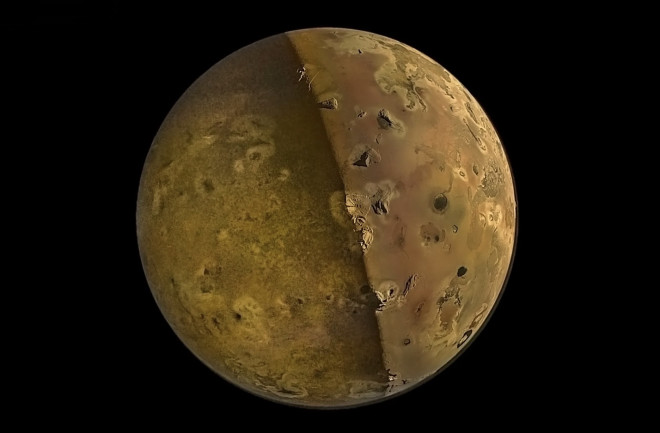In both December 2023 and February 2024, NASA’s Juno spacecraft soared over Jupiter’s moon, Io. Shooting past at a distance of around 930 miles, the twin flybys — the two closest flybys of Io in over 20 years — produced images of the moon’s lava lakes and volcanic plumes, fleshing out our impression of our solar system’s most volcanic world.
According to NASA scientists, the images could contribute to our understanding of Io’s volcanism, confirming the patterns and the origins of the moon’s intense volcanic activity. The images also call attention to our advancing knowledge of the Jovian system, and the solar system as a whole, recalling a time when Io was mistakenly seen as an inactive, idle place.
“The Juno science team is studying how Io’s volcanoes vary,” said astrophysicist Scott Bolton, Juno’s principal investigator, in a statement before the December flyby. “We are looking for how often they erupt, how bright and hot they are, how the shape of the lava flow changes, and how Io’s activity is connected to the flow of charged particles in Jupiter’s magnetosphere.”
Read More: With Icy Volcanoes, The Moon Europa Is Obscure, Along With These 3 Other Moons
A ‘Dead Moon’ Comes Alive
The third biggest moon in Jupiter’s “Jovian” system, Io is no stranger to the rumbles and roars of volcanoes. That’s because it’s richer in volcanic activity than any other moon in our solar system, surging with plumes that sometimes spew more than 300 miles above its sharp, mountainous surface.
But Io wasn’t always perceived as a particularly active moon. For decades, it was described as a “dead moon” trapped in time, a world without any active geology.
It wasn’t until NASA’s Voyager 1 spacecraft that this interpretation of Io was proven wrong. Shooting into space in 1977, the spacecraft captured the first close-ups of Io in 1979, from around 12,780 miles away. The close-ups showed a massive volcanic plume shooting from the moon’s surface, suggesting that Io wasn’t as geologically dead as traditionally thought.
Some scientists at the time were already starting to suspect that Io was active thanks to Jupiter’s gravitational pull, warping and warming the moon’s interior. But it was Voyager 1 that substantiated their suspicions, finding the first active volcano outside our planet on its faraway terrain.
Read More: First Evidence of a Recently Active Volcano on Mars
Capturing Io’s Volcanic Activity
Today, Voyager 1 is far from Jupiter, drifting deeper and deeper into interstellar space. But Jupiter and its many moons are not sitting unstudied. Instead, NASA’s Juno spacecraft, a successor of Voyager 1 in the investigation of the Jovian system, is studying Jupiter and its 95 natural satellites. Since its arrival in the system in 2016, the spacecraft has observed Io from afar, monitoring the moon’s surface with its JunoCam imager from anywhere from 6,830 miles to 62,100 miles away.
These past observations have helped researchers dive deeper into Io’s volcanic activity, allowing them to piece together a map of the moon’s active volcanoes, published this past November. But the close flybys on Dec. 30, 2023 and Feb. 3, 2024, provided some of the sharpest images of Io yet, with pictures of peaks and plumes never before seen.
Studying these images could reveal Io’s patterns of volcanic activity — a tough task turned tougher by blurry and inadequate imagery. Not only that; the images could also clear up the origin of Io’s volcanos, determining the degree of Jupiter’s influence on the moon’s rocky outbursts.
“With our pair of close flybys in December and February, Juno will investigate the source of Io’s massive volcanic activity, whether a magma ocean exists underneath its crust, and the importance of tidal forces from Jupiter, which are relentlessly squeezing this tortured moon,” Bolton added in a statement.
NASA prolonged Juno’s mission in January 2021, meaning that the spacecraft should continue to circle Jupiter and its moons until September 2025. A total of 18 future flybys are planned for Io in that time, providing plenty of chances for scientists to study Jupiters’s most active, most explosive moon further.
Read More: Supervolcano Discovered on Pluto
Article Sources
Our writers at Discovermagazine.com use peer-reviewed studies and high quality sources for our articles, and our editors review for scientific accuracy and editorial standards. Review the sources used below for this article:
NASA. For Your Processing Pleasure: The Sharpest Pictures of Jupiter’s Volcanic Moon Io in a Generation
NASA. Io
NASA Jet Propulsion Laboratory. NASA’s Juno to Get Close Look at Jupiter’s Volcanic Moon Io on Dec. 30
NASA Jet Propulsion Laboratory. Spacecraft at Io Sees and Sniffs Tallest Volcanic Plume
NASA Science Space Place. Space Volcanos
NASA. Voyager 1
Science. Melting of Io by Tidal Dissipation
NASA. Juno
NASA. Moons of Jupiter
Nature. Io’s Polar Volcanic Thermal Emission Indicative of Magma Ocean and Shallow Tidal Heating Models

